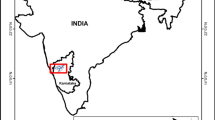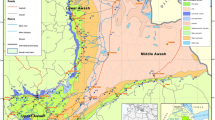Abstract
Accurate forecasting of rainfall is important in the effective management of water resources, particularly in arid regions. The wavelet analysis-support vector machine coupled model (WA-SVM) was evaluated for 1, 3 and 6 months ahead rainfall forecasting. The coupled model was obtained by combining the discrete wavelet transform (DWT) and support vector machine (SVM) methods. Monthly rainfall data from the Qilian, Yeniugou and Tuole stations in Qilian Mountains, China were used to optimize the model. By comparing the model output with the observed data on the basis of the coefficient of correlation (R), root mean squared error (RMSE), mean absolute error (MAE) and Nash-Sutcliffe efficiency coefficient (NS), it was found that the performances of WA-SVM models for 1, 3 and 6-month ahead rainfall forecasting were good, and the models have forecasted the rainfall values with reasonable accuracy in all the statistical indices during testing period. Relative to the performance of regular SVM models, we show that the WA-SVM model demonstrates superior accuracy among the SVM models in forecasting rainfall at all tested lead times, probably due to a wavelet transform effect on the SVM predictive ability. The WA-SVM model was also compared with conventional ANN models, and the WA-SVM model was found to be significantly superior. The results of the study indicate that the WA-SVM model is preferable and can be applied successfully because it provides high accuracy and reliability for multi-time ahead monthly rainfall forecasting.







Similar content being viewed by others
References
Adamowski JF (2008) Development of a short-term river flood forecasting method for snowmelt driven floods based on wavelet and cross-wavelet analysis. J Hydrol 353:247–266
Aksoy H, Dahamsheh A (2008) Artificial neural network models for forecasting monthly precipitation in Jordan. Stoch Environ Res Risk Assess 23:917–931
Anctil F, Coulibaly P (2004) Wavelet analysis of the interannual variability in Southern Quebec streamflow. J Clim 17:163–173
Andreo B, Jiménez P, Durán JJ, Carrasco F, Vadillo I, Mangin A (2006) Climatic and hydrological variations during the last 117–166 years in the south of the Iberian Peninsula, from spectral and correlation analyses and continuous wavelet analyses. J Hydrol 324:24–39
Boser BE, Guyon IM, Vapnik VN (1992) A training algorithm for optimal margin classifiers. Proceedings of the Fifth Annual Workshop on Computational Learning Theory. ACM Press, pp 144–152
Chang CC, Lin CJ (2011) LIBSVM: a library for support vector machines. ACM Trans Intell Syst Technol 2:1–27, Software available at http://www.csie.ntu.edu.tw/~cjlin/libsvm
Dabuechies I (1990) The wavelet transform, time-frequency localization and signal analysis. IEEE Trans Inf Theory 36:6–7
Dahamsheh A, Aksoy H (2008) Artificial neural network models for forecasting intermittent monthly precipitation in arid regions. Meteorol Appl 16:325–337
Drago AF, Boxall SR (2002) Use of the wavelet transform on hydro-meteorological data. Phys Chem Earth 27:1387–1399
Freiwan M, Cigizoglu HK (2005) Prediction of total monthly rainfall in Jordan using feed forward back propagation method. Fresenius Environ Bull 14:142–151
French MN, Krajewski WF, Cuykendall RR (1992) Rainfall forecasting in space and time using neural network. J Hydrol 137:1–31
Georgakakos KP, Bras RL (1984) A hydrologically useful station precipitation model: 1. Formulation. Water Resour Res 20:1585–1596
Haykin S (1999) Neural Networks: a comprehensive foundation, 2nd edn. Prentice-Hall, Englewood Cliffs
Hsu CW, Chang CC, Lin CJ (2010) A practical guide to support vector classification. http://www.csie.ntu.edu.tw/~cjlin/papers/guide/guide.pdf. Accessed 15 Apr 2010
Kang S, Lin H (2007) Wavelet analysis of hydrological and water quality signals in an agricultural watershed. J Hydrol 338:1–14
Kashid SS, Maity R (2012) Prediction of monthly rainfall on homogeneous monsoon regions of India based on large scale circulation patterns using Genetic Programming. J Hydrol 454:26–41
Kim TW, Valdes JB (2003) Nonlinear model for drought forecasting based on a conjunction of wavelet transforms and neural networks. J Hydrol Eng 8:319–328
Kisi O, Cimen M (2012) Precipitation forecasting by using wavelet-support vector machine conjunction model. Eng Appl Artif Intell 25:783–792
Kisi O, Shiri J (2011) Precipitation forecasting using wavelet–genetic programming and wavelet-neuro-fuzzy conjunction models. Water Resour Manag 25:3135–3152
Labat D (2010) Cross wavelet analyses of annual continental freshwater discharge and selected climate indices. J Hydrol 385:269–278
Lin JY, Cheng CT, Chau KW (2006) Using support vector machines for long-term discharge prediction. Hydrol Sci J 51:599–612
Mallat SG (1998) A wavelet tour of signal processing, 2nd edn. Academic, San Diego
Meyer Y (1993) Wavelets algorithms applications. SIAM, Philadelphia
Moriasi DN, Arnold JG, Van Liew MW, Bingner RL, Harmel RD, Veith TL (2007) Model evaluation guidelines for systematic quantification of accuracy in watershed simulations. Trans ASABE 50:885–900
Moustris KP, Larissi IK, Nastos PT, Paliatsos AG (2011) Precipitation forecast using artificial neural networks in specific regions of Greece. Water Resour Manag 25(8):1979–1993
Nourani V, Alami MT, Aminfar MH (2009) A combined neural-wavelet model for prediction of Ligvanchai watershed precipitation. Eng Appl Artif Intell 22:466–472
Özger M, Mishra AK, Singh VP (2010) Scaling characteristics of precipitation data in conjunction with wavelet analysis. J Hydrol 395:279–288
Partal T (2009) River flow forecasting using different artificial neural network algorithms and wavelet transform. Can J Civil Eng 36:26–38
Partal T, Cigizoglu HK (2009) Prediction of daily precipitation using wavelet—neural networks. Hydrol Sci J 54:234–246
Partal T, Kişi Ö (2007) Wavelet and neuro-fuzzy conjunction model for precipitation forecasting. J Hydrol 342:199–212
Rajaee T (2011) Wavelet and ANN combination model for prediction of daily suspended sediment load in rivers. Sci Total Environ 409:2917–2928
Srivastava G, Panda SN, Mondal P, Liu J (2010) Forecasting of rainfall using ocean-atmospheric indices with a fuzzy neural technique. J Hydrol 395:190–198
Sudheer KP, Gosain AK, Ramasastri KS (2002) A data-driven algorithm for constructing artificial neural network rainfall-runoff models. Hydrol Process 16:1325–1330
Valverde Ramírez MC, de Campos Velho HF, Ferreira NJ (2005) Artificial neural network technique for rainfall forecasting applied to the São Paulo region. J Hydrol 301:146–162
Vapnik VN (1995) The nature of statistical learning theory. Springer, New York
Venkata Ramana R, Krishna B, Kumar SR, Pandey NG (2013) Monthly rainfall prediction using wavelet neural network analysis. Water Resour Manag 27:3697–3711
Wu CL, Chau KW, Fan C (2010) Prediction of rainfall time series using modular artificial neural networks coupled with data-preprocessing techniques. J Hydrol 389:146–167
Acknowledgments
This research was supported by the National Natural Sciences Foundation of China (No. 31370466, 91025002, 31270482), the Fundamental Research Funds for the Central Universities (GK201101002), the Key Project of the Chinese Academy of Sciences (KZZD-EW-04-05), and National Key Technology R & D Program (No. 2007BAD46B01). Qi Feng designed research; Xiaohu Wen wrote the paper andJianguo Li performed research and analyzed data. We also thank Jianhua Si, China for help in writing this paper, and 2 anonymous reviewers for their comments on an earlier version of this manuscript.
Author information
Authors and Affiliations
Corresponding author
Rights and permissions
About this article
Cite this article
Feng, Q., Wen, X. & Li, J. Wavelet Analysis-Support Vector Machine Coupled Models for Monthly Rainfall Forecasting in Arid Regions. Water Resour Manage 29, 1049–1065 (2015). https://doi.org/10.1007/s11269-014-0860-3
Received:
Accepted:
Published:
Issue Date:
DOI: https://doi.org/10.1007/s11269-014-0860-3




